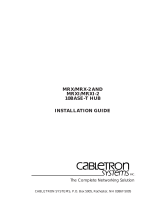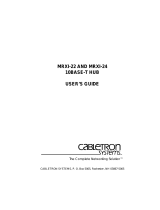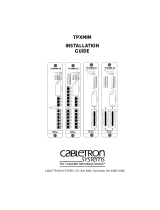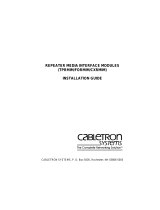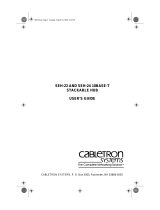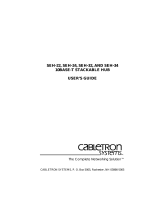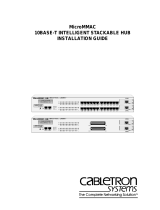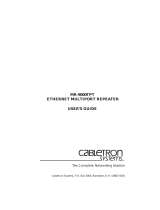Page is loading ...

Receive (RCV)
When this yellow LED flashes, the TPT-D4 is receiving
data from the network. If attached to a repeater, the
LED flashes when data passes through the TPT-D4.
The flash is pulse-stretched for viewing effect.
Collision (CLN)
When this red LED flashes, the transceiver detected a
collision condition or a jabber packet on the network.
The flash frequency may increase as network activity
increases, since more collisions are likely to occur.
The LED flash is pulse-stretched for viewing effect.
Link OK (LNK)
When this green LED is on, a link exists between the
transceiver and the device at the other end of the
twisted pair segment. LNK remains lit as long as the
link is maintained. Both ports can show a valid link.
Active Port (ACT)
When this yellow LED is on solid, its associated RJ45
port is handling all network traffic through the
transceiver.
Only one port can be active; the inactive port ACT
LED is turned off. A flashing ACT LED indicates that
the associated RJ45 port is the active port and it is in
the Idle state. A slow flash indicates that the time-out
period is set to 10 seconds; a fast flash indicates that
the time-out period is set to 2 seconds.
GETTING HELP
If you need additional support related to the TPT-D4 or
if you have any questions, comments, or suggestions
related to this manual, contact Cabletron Systems
Technical Support:
By Phone: Monday through Friday 8 A.M. to
8 P.M. Eastern Time at:
(603) 332-9400.
By CompuServe: GO CTRON from any ! prompt
By Internet mail: suppor[email protected]
NOTICE
Cabletron Systems reserves the right to make changes in
specifications and other information contained in this document
without prior notice. The reader should in all cases consult Cabletron
Systems to determine whether any such changes have been made.
The hardware, firmware, or software described in this manual is
subject to change without notice.
IN NO EVENT SHALL CABLETRON SYSTEMS BE LIABLE FOR
ANY INCIDENTAL, INDIRECT, SPECIAL, OR CONSEQUENTIAL
DAMAGES WHATSOEVER (INCLUDING BUT NOT LIMITED TO
LOST PROFITS) ARISING OUT OF OR RELATED TO THIS MANUAL
OR THE INFORMATION CONTAINED IN IT, EVEN IF CABLETRON
SYSTEMS HAS BEEN ADVISED OF, KNOWN, OR SHOULD HAVE
KNOWN, THE POSSIBILITY OF SUCH DAMAGES.
FCC NOTICE
This device complies with Part 15 of the FCC rules. Operation is
subject to the following two conditions: (1) this device may not
cause harmful interference, and (2) this device must accept any
interference received, including interference that may cause
undesired operation.
Note:
This equipment has been tested and found to comply with
the limits for a Class A digital device, pursuant to Part 15 of the
FCC rules. These limits are designed to provide reasonable
protection against harmful interference when the equipment is
operated in a commercial environment. This equipment uses,
generates, and can radiate radio frequency energy and if not
installed in accordance with the operator’s manual, may cause
harmful interference to radio communications. Operation of this
equipment in a residential area is likely to cause interference in
which case the user will be required to correct the interference at
his own expense.
Warning:
Changes or modifications made to this device which are
not expressly approved by the party responsible for compliance
could void the user’s authority to operate the equipment.
DOC NOTICE
This digital apparatus does not exceed the Class A limits for radio
noise emissions from digital apparatus set out in the Radio
Interference Regulations of the Canadian Department of
Communications.
Le présent appareil numérique n’émet pas de bruits
radioélectriques dépassant les limites applicables aux appareils
numériques de la class A prescrites dans le Règlement sur le
brouillage radioélectrique édicté par le ministère des
Communications du Canada.
VCCI NOTICE
This equipment is in the 1st Class Category (information
equipment to be used in commercial and/or industrial areas) and
conforms to the standards set by the Voluntary Control Council for
Interference by Information Technology Equipment (VCCI) aimed
at preventing radio interference in commercial and/or industrial
areas.
Consequently, when used in a residential area or in an adjacent
area thereto, radio interference may be caused to radios and TV
receivers, etc.
Read the instructions for correct handling.
© Copyright May 1995 by:
Cabletron Systems, Inc.
P.O. Box 5005, Rochester, NH 03866-5005
All Rights Reserved
Printed in the United States of America
Order Number: 9030877-01, May 1995
TPT-D4
is a trademark of Cabletron Systems, Inc.
LANVIEW
is a registered trademark of Cabletron Systems, Inc.
Ethernet
is a trademark of Xerox Corporation.
CompuServe
is a registered trademark of CompuServe, Inc.
TPT-D4
10BASE-T TWISTED PAIR
REDUNDANT TRANSCEIVER
The TPT-D4 twisted pair transceiver links two
Ethernet devices through 10BASE-T twisted pair
and attachment unit interface (AUI) cable segments.
Dual twisted pair ports with RJ45 connectors
provide redundant data paths for critical
applications. If the primary port (port 1) does not
receive any data for either 2 or 10 seconds (switch
selectable), the port enters the Idle state. If the
back-up port (port 2) receives data during the Idle
state, it becomes the active port. When the primary
port senses data again, it switches back to become
the active port. Also, if a segment becomes
disconnected from the primary port, the data path
automatically switches to the back-up port. To avoid
the creation of a data loop, only one port can be
active at any one time. You can connect the two
transceiver ports to the same network device,
different network devices, or even different
networks.
REQUIREMENTS
The TPT-D4 transceiver complies with IEEE 802.3
10BASE-T specifications. For the best network
performance, be sure to observe the following
network guidelines.
SQE
O
MIN MAX
SN
TPT-D4
802.3 10BASE-T
REDUNDANT TRANSCEIVER
with LANVIEW
O
P
W
R
O
S
Q
E
O
X
M
T
O
R
C
V
O
C
L
N
LNK
O
1
2
x
x
==
SP
Primary Port
Back-up Port
ACT
O
LNK
O
ACT
O
AUI Port*
*AUI connector not shown
Primary Port
Back-up Port

Twisted Pair Segment Length
The IEEE 802.3 10BASE-T standard requires that
devices support a 100-meter minimum segment length
when using a 10BASE-T compliant medium.
If the signal loss is less than 11.5 dB at all frequencies
between 5 and 10 MHz, support for longer segments
of up to 200 meters is possible.
AUI Cable
The AUI cable you use to connect the TPT-D4 to an
Ethernet device can be up to 50 meters long and must
comply with IEEE 802.3 specifications.
OPERATING SPECIFICATIONS
Cabletron Systems reserves the right to change these
specifications at any time without notice.
Power Supply
Input Current: 500 mA
Input Voltage: 12.0 Vdc typical; 9.5 Vdc min;
15.75 Vdc max
AUI Connector
The AUI connector is a 15-Position D-type receptacle
shell connector attached to the TPT-D4 case.
RJ45 Port
The TPT-D4 has a switch at each RJ45 port that lets
you select a crossover (X) or straight-through (=) pin
configuration.
Operating Environment
Operating Range: 5
°
to 40
°
C (41
°
to 104
°
F)
Heat Output: 17 Btu/hr
Humidity Range: 5% to 95% (non-condensing)
Storage Range: -30
°
to +80
°
C (-22
°
to 176
°
F)
Pos 8 Logic Ref.
Pos 7 No Connection
Pos 6 Power Return
Pos 5 Receive +
Pos 4 Logic Ref.
Pos 3 Transmit +
Pos 2 Collision +
Pos 1 Logic Ref.
Pos 15 No Connection
Pos 14 Logic Ref.
Pos 13 Power (+12 Vdc)
Pos 12 Receive -
Pos 11 Logic Ref.
Pos 10 Transmit -
Pos 9 Collision -
1 2 3 4 5 6 7 8
Pin 1 RX+
Pin 2 RX-
Pin 3 TX+
Pin 4 No Connection
Pin 5 No Connection
Pin 6 TX-
Pin 7 No Connection
Pin 8 No Connection
X
Pin 1 TX+
Pin 2 TX-
Pin 3 RX+
Pin 4 No Connection
Pin 5 No Connection
Pin 6 RX-
Pin 7 No Connection
Pin 8 No Connection
=
Safety
This unit meets the requirements of UL 1950,
CSA C22.2 No. 950, and EN 60950.
Emissions
Meets the requirements of EN 55022 Class A; FCC
Part 15, Class A; and VCCI Class I emission limits.
Note
: It is the responsibility of the person who sells
the system to which the TPT-D4 will be a part to
ensure that the total system meets allowed limits of
conducted and radiated emissions.
Immunity
Meets the requirements of EN50082-1, IEC 801-2,
IEC 801-3, and IEC 801-4.
INSTALLATION
When you install the TPT-D4 transmitter, be sure to
observe the operating requirements and
specifications listed previously. To install the TPT-
D4, proceed as follows:
Caution:
To prevent equipment damage
,
set the
SQE and MIN/MAX switches using a nonconductive
probe, or disconnect the transceiver AUI connector
to remove power from the device.
1. Set the SQE Switch.
Note:
The SQE (Signal Quality Error) test function
must be disabled if you connect the TPT-D4
transceiver to a repeater or to an Ethernet Version 1
device. Devices that do not support the SQE test
function will interpret the SQE test pulse as a
collision. In addition, some of the Version 2
equipment does not support the SQE test.
The SQE switch is a two position switch located on
the top of the transceiver. The SQE switch is factory
set to the ON position ( ). To disable the SQE test
function, slide the SQE switch to the OFF position
( ), as indicated on the front of the transceiver.
2. Set the MIN/MAX Switch.
The MIN/MAX switch sets the time duration that the
TPT-D4 waits for data before switching to the
redundant port. MIN equals approximately 2
seconds and MAX equals approximately 10
seconds. If you attach the TPT-D4 to a high-activity
network, select the MIN setting. If you attach the
TPT-D4 to a low-activity network, select the MAX
setting.
3. Set the Crossover Switches.
A crossover switch at each of the two RJ45 ports
allows you to select a crossover (X) or straight-
through (=) pin configuration for that RJ45 port.
When you attach a twisted pair cable to a TPT-D4
RJ45 port, check the pin configuration of the RJ45
connector on the device to be connected. Then set
the associated TPT-D4 port crossover switch so the
twisted pair TX and RX signal pairs connect as
follows:
4. Connect the TPT-D4 to the network as follows:
a. Attach a twisted pair cable from the
transceiver to the network device.
b. Attach the AUI cable to the Ethernet device.
c. Check the LANVIEW indicators. The PWR
LED should be lit to indicate that the
transceiver is receiving power through the
AUI cable. The LNK LEDs should be lit to
indicate that the twisted pair ports are
linked to the network device.
USING LANVIEW
LANVIEW is Cabletron Systems built-in diagnostic
and status monitoring system.
Power (PWR)
When this green LED is on, the TPT-D4 transceiver
is receiving power through its AUI connector. If the
PWR LED is off, power is not being received or the
dc-to-dc converter in the transceiver has failed.
Signal Quality Error (SQE)
When this yellow LED is on, the transceiver SQE
test function is selected. The SQE test is used to
ensure that the collision presence circuit and the
path between the Ethernet device and the
transceiver are operational.
Transmit (XMT)
When this green LED flashes, the transceiver is
transmitting data. The LED flash is pulse-stretched
for viewing effect. The LED is off when the device is
active but not transmitting.
RX+
RX-
TX+
TX-
TX+
TX-
RX+
RX-
/

